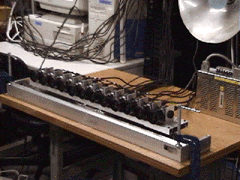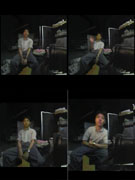
Click the image to view a mpeg movie.


Click the image to view a mpeg movie.

We have been developing a system named "mutual telexistence" which allows for face-to-face communication between remote users. Unlike most conventional tele-conferencing systems which limit the users' viewpoint to a fixed position, mutual telexistence system should provide the images of the other users corresponding to the change of a user's eye position in the computer generated three-dimensional space.
On the other hand, the technique called "image-based rendering" has emerged recently. By using this technique, complex photo-realistic images at arbitrary viewpoint can be effectively synthesized. Fundamentally employing this technique, however, our system must synthesize the image in real-time for smooth communication. Thus, our prototype system has the following features to fulfill this "real-time" request:
 Click the image to view a mpeg movie. |
 |
 Click the image to view a mpeg movie. |
| Figure 1. Prototype System | Figure 2. Synthesized Video Sequence |
|
The left picture of Figure 1 shows our prototype system, and the right one is its block diagram. This system consists of the camera unit, the rendering PC, and the control PC. In the camera unit, 12 small color CCD cameras are aligned horizontally in a row on the linear actuator with their intervals 54mm. These cameras are located on the gantry with rotating around their optical axes. Thus, the direction of their scanning lines is vertical. Moreover, all these cameras are synchronized by the same genlock signal and a video switch is installed between the camera unit and the rendering PC. This design allows the rendering PC to capture only one scanning line selectively among 12 video streams, which result in the reduction of data and the saving of a number of video capturing devices. The rendering PC synthesizes the images of the object from arbitrary viewpoint by texture-mapping captured vertically long tile image on a transparent plane in the computer-generated three-dimensional space. The control PC indicates the channel of this switch and controls the motion of the linear actuator.
Click Figure 2 and see a video sequence synthesized by our system. Moving human figures are successfully rendered in real-time.
More specific technical data are available in http://www.star.t.u-tokyo.ac.jp/projects/mutel/.